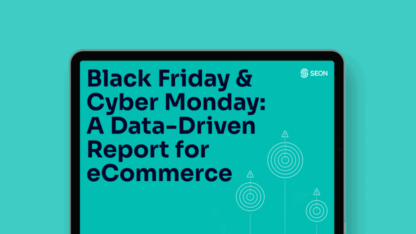In 2024, nearly 70% of retailers will report higher fraud losses, driven by advanced techniques like generative AI, which creates hard-to-detect deepfakes and synthetic identities.
As fraud continues to evolve, transaction monitoring, the continuous process of reviewing and analyzing financial transactions to detect suspicious activities that may indicate fraud, plays an important role in identifying and reducing financial crimes, ensuring regulatory compliance and analyzing data for valuable insights into customer behaviors, preferences and purchasing patterns.
Why Online Retailers Need Transaction Monitoring
Transactions are the lifeblood of ecommerce. As such, robust transaction monitoring is crucial for online retailers for several key reasons:
- Fraud Prevention: With the rise of sophisticated fraud techniques, real-time transaction monitoring helps to identify unusual patterns, suspicious behaviors or anomalies that deviate from established norms. This is critical for preventing financial losses and protecting customer data from breaches.
- Regulatory Compliance
Many jurisdictions require businesses to implement anti-money laundering (AML) and know-your-customer (KYC) protocols to meet regulatory requirements. Retailers must comply with regulations such as the Payment Card Industry Data Security Standard (PCI DSS) and AML laws. Transaction monitoring ensures compliance by detecting bad actors’ activities, thus avoiding legal penalties. - Customer Insights
Monitoring customer transactions delivers valuable insights into customer behaviors, preferences and trends, which can be used to improve customer experience and service offerings. - Operational Efficiency
Automating the transaction monitoring process reduces the need for manual intervention, freeing up staff to focus on higher-value activities that can increase a retailer’s overall efficiency.
Retail and AML
While AML regulations have traditionally been associated with financial institutions, the retail sector is increasingly becoming a target for money laundering activities. As online transactions dominate the retail landscape, criminals exploit these platforms to legitimize illicit funds. The industry is more responsible for implementing robust AML measures, with transaction monitoring at the forefront.
In retail, AML screening efforts focus on identifying suspicious patterns that may indicate money laundering. These can include large purchases, a series of high-value transactions in quick succession or purchases that don’t align with a customer’s typical behavior. Sophisticated transaction monitoring systems can flag these anomalies in real time, allowing retailers to investigate and report suspicious activities to the relevant authorities.
As regulations evolve to address the growing threat of money laundering in ecommerce, retailers must ensure their AML programs are adaptable and comply with the latest guidelines.
The Global Perspective on Transaction Monitoring for Online Retailers
Transaction monitoring requirements and practices vary significantly across different regions and countries, presenting unique global challenges for online retailers. Here’s an overview of how these differences manifest in key markets:
- European Union (EU)
The 6th Anti-Money Laundering Directive (AMLD6) sets the standard for transaction monitoring in the EU. It requires businesses, including online retailers, to implement risk-based approaches to detect suspicious transactions. The EU also emphasizes data protection through GDPR, which impacts how customer data can be used in monitoring processes. - United States
The US approach is more sector-specific. While banks are heavily regulated under the Bank Secrecy Act, online retailers fall under broader regulations like the USA PATRIOT Act. Different states may have additional requirements, such as California’s stringent data privacy laws. - Asia-Pacific
Countries in this region have diverse approaches. For instance, Japan has strict AML laws that apply to many businesses, including online retailers. Singapore emphasizes technology in its AML approach, encouraging AI and machine learning in transaction monitoring. China has unique challenges due to its sizeable mobile payment ecosystem, requiring specialized monitoring techniques. - Latin America Many Latin American countries are strengthening their AML laws. Brazil, for example, has expanded its AML regulations to cover more types of businesses, including certain retailers.
- Middle East and Africa These regions are rapidly developing their regulatory frameworks. The UAE, for instance, has recently tightened its AML laws, affecting businesses across sectors, including ecommerce.
Global online retailers need flexible transaction monitoring systems that adapt to varying regulations. By adjusting to regional differences, they can build compliant systems that protect their business and support international growth.
Learn more about tools that help you boost your AML compliance without friction.
Read Here
How SEON Helps Online Retailers with Transaction Monitoring
Changing fraud and money laundering threats and stringent regulatory requirements necessitate a proactive and technologically advanced approach to transaction monitoring.
Platforms such as SEON provide retailers the tools they need to navigate today’s complex environment. By offering comprehensive screening capabilities, businesses can screen individuals and entities against various watchlists, including politically exposed persons (PEPs), sanctions lists and crime databases. These solutions also provide customization and automation features, allowing retailers to tailor their AML screening processes to meet specific needs and regulatory requirements. Retailers can also set up custom rules and leverage machine learning to reduce false positives, making the screening process efficient and precise.
By implementing transaction monitoring, retailers protect themselves from financial losses and regulatory penalties and gain valuable insights into customer behavior. This dual benefit of security and business intelligence positions retailers to thrive in an increasingly digital and regulated marketplace.
Sources
- PYMNTS: Police Allege Money Launderers Are Using Chinese eCommerce Sites To Move Money
- Experian: Fraud Trends 2024 – Experience’s Future Fraud Forecast








